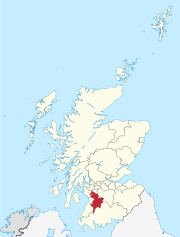Cumnock
Cumnock
| |
|---|---|
| Town | |
 Old Cumnock Old Church and mercat cross | |
 Cumnock Location within East Ayrshire | |
| Population | 8,830 (mid-2016 est.)[1] |
| Language | English Scots |
| OS grid reference | NS569200 |
| • Edinburgh | 54 mi (87 km) |
| • London | 321 mi (517 km) |
| Council area | |
| Lieutenancy area | |
| Country | Scotland |
| Sovereign state | United Kingdom |
| Post town | CUMNOCK |
| Postcode district | KA18 |
| Dialling code | 01290 |
| Police | Scotland |
| Fire | Scottish |
| Ambulance | Scottish |
| UK Parliament | |
| Scottish Parliament | |
Cumnock (Cumnag in Gaelic) is a town in East Ayrshire, Scotland. The town sits at the confluence of the Glaisnock Water and the Lugar Water. There are three neighbouring housing projects which lie just outside the town boundaries, Craigens, Logan and Netherthird, with the former ironworks settlement of Lugar also just outside the town, contributing to a population of around 13,000 in the immediate locale. A new housing development, Knockroon, was granted planning permission on 9 December 2009 by East Ayrshire Council.[2]
History[]
Early Cumnock[]
Etymology[]
The origin of the name "Cumnock" has been debated over the years and several interpretations have been offered.
- Com-cnoc, (hollow of the hills)
- Com-oich, (meeting of the waters)
- Cam-cnoc, (crooked hill)
- Cumanag, (little shrine)[3]
Early history[]
This part of Ayrshire has seen human settlement for over 5,000 years. There are many Bronze Age burial sites around the nearby area.[3]
Medieval history[]
It is believed that a place of worship has existed in Cumnock's Square for over 1,100 years, though the records begin in about 1275. The patron saint of Cumnock is Saint Conval. James IV created the Burgh of Cumnock.[3] Three castles existed in the parish of Old Cumnock, namely Borland, Terringzean and Lefnories or Lochnorris. Lefnories was the largest and was replaced as a dwelling by Dumfries House, with only the below ground foundations remaining, excavated by the Marquess of Bute in the late 19th century.
Industrial Cumnock[]
This section does not cite any sources. (August 2017) |
Cumnock housed many miners, and also served as the market town for the other, smaller towns in the district, like Auchinleck, Lugar, Muirkirk, Ochiltree and New Cumnock (the original Cumnock/Comenagh/Comno etc.)
The town has a strong socialist heritage due to its history as a mining centre. The father of the Labour Party, James Keir Hardie, lived in the town for a large part of his life, and his statue sits outside the town hall. A small housing scheme in the town (Keir Hardie Hill) is named after him. The left-wing politician Emrys Hughes was local MP for a time in the mid-20th century, and also lived in the town.
William Wallace allegedly spent 3 months in the seat of Patrick Dunbar ((New) Cumnock or Cumno in 1296), according to the poem, The Wallace, by Blind Harry. Cumnock is also in the heart of Robert Burns country and the poet is said to have spent time there.
Churches[]
The town has six churches, five Protestant churches, the Congregational Church, Old Cumnock Old Parish Church, St Andrew's United Free Church, Cumnock Trinity Church, Cumnock Baptist Church, and the Roman Catholic St John the Evangelist Church (1878-1880), by architect William Burges for the third Marquess of Bute. [1].[4]
Sports[]
The local football team is Cumnock Juniors, who compete in the West of Scotland League Premier Division and play their home matches at Townhead Park. The team is famous for their bitter rivalry with local neighbours, Auchinleck Talbot. The town also boasts an athletics park and rugby club Cumnock RFC, as well as a modern sports centre containing fitness gym and swimming pool.[5]
Notable residents[]
- Mark Bennett, Scottish international rugby player
- James MacMillan, composer
- George Burley, former footballer mostly playing for Ipswich Town, and manager for Ipswich Town, Derby County etc.
See also[]
- Cumnock and Holmhead
- Terringzean Castle
- Black Loch, New Cumnock
- Lands of Borland, Barony of Cumnock
References[]
- ^ "Mid-2016 Population Estimates for Settlements and Localities in Scotland". National Records of Scotland. 12 March 2018. Retrieved 30 December 2020.
- ^ East Ayrshire Council Archived 2011-04-06 at the Wayback Machine
- ^ Jump up to: a b c Cumnock History Group
- ^ "Cumnock, Car Road, St John's Roman Catholic Church | Canmore". canmore.org.uk. Retrieved 17 September 2019.
- ^ https://www.visionsleisure.com/[bare URL]
External links[]
- Cumnock History Group Cumnock History Group site, extensive information on the history of Cumnock
- Cumnock Action Plan [2] What's happening in Cumnock
- cumnockchronicle The local community site for Cumnock, more information on Cumnock
- tripod.com more information on The Wallace
- [3] Video footage of the Moot Hill, Gallows Hill, etc.
- Cumnock
- Towns in East Ayrshire

